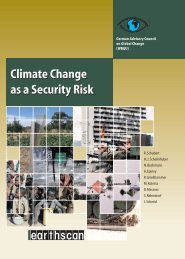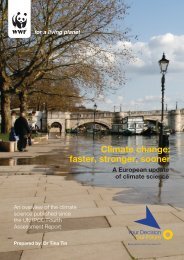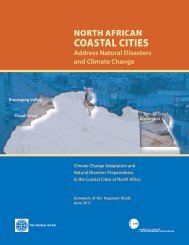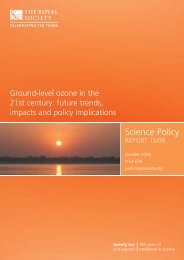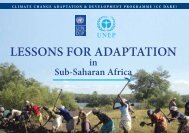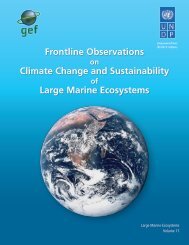Climate change futures: health, ecological and economic dimensions
Climate change futures: health, ecological and economic dimensions
Climate change futures: health, ecological and economic dimensions
Create successful ePaper yourself
Turn your PDF publications into a flip-book with our unique Google optimized e-Paper software.
The rise in minimum temperature results in the expansioninto higher latitudes, which is explained by theinverse relationship between tick survival <strong>and</strong> thedegree of subfreezing temperature exposure (V<strong>and</strong>yk etal. 1996). This trend is clearly shown by the spreadingof suitable area north into Canada. Though I.scapularis has been collected from a variety of locationsin Canada (Keirans et al. 1996, Scotter 2001),establishment has only been shown for a limited numberof locations in southern Ontario (Schwartz et al.1997). <strong>Climate</strong> <strong>change</strong> may provide the conditionsnecessary to yield reproducing populations of I. scapulariseither by the systematic advancement from southof the border by movement on mammal hosts or byintroductions via attachment to bird hosts (Klich etal. 1996).SPECIFIC RECOMMENDATIONSFurther study of Lyme disease <strong>and</strong> other tick-borne diseasesis warranted. Tick-borne diseases includebabesiosis (an animal, malaria-like illness), erhlichiosis(bacterial), Rocky Mountain spotted fever <strong>and</strong> Q fever(rickettsial diseases), <strong>and</strong> especially in Europe, tickborneencephalitis (a viral disease). The possible roleof ticks is being studied in the investigation of an outbreakof tularemia (“rabbit fever”) that has persisted onMartha’s Vineyard, MA (USA) since 2000. A Lyme-likedisease has been reported in the southern US(Mississippi, South Carolina, Georgia, Florida, <strong>and</strong>Texas) that also responds to antibiotics, <strong>and</strong> the possiblerole of other ticks in transmitting Lyme is understudy.Minimum temperature increase alsoresults in the extension of suitabilityinto higher altitudes. Elevation is animportant limiting factor for I. scapularispopulations as it indirectly affects populationestablishment through its influenceon the complex interactionbetween climate, physical factors <strong>and</strong>biota (Schulze et al. 1994). As a resultof increasing temperatures, the modelpredicts advancement of suitability intothe southern Appalachian Mountains.Models that predict disease emergence can be valuabletools for preparing <strong>health</strong> professionals <strong>and</strong>strengthening public <strong>health</strong> interventions. Personal protectivemeasures for high-risk populations can reduceinfection rates. Environmental methods, including hosttargetedvaccination <strong>and</strong> larvacides, have shownpromise <strong>and</strong> have the potential to limit the spread ofLyme disease.47 | INFECTIOUS AND RESPIRATORY DISEASESCCF-II: SURPRISE IMPACTSLyme disease is a slowly advancing disease, given itscomplex life cycle involving ticks, deer, white-footedmice <strong>and</strong> the supporting habitat <strong>and</strong> food sources forall these elements. Very warm winters may <strong>change</strong> thesuitable habitat more rapidly than expectations basedon <strong>change</strong>s in average temperatures alone. But, dueto the many components of the life cycle, <strong>and</strong> the twoyearcycle of the ticks themselves, it is unlikely that thisdisease will <strong>change</strong> its distribution <strong>and</strong> incidenceabruptly <strong>and</strong> explosively.CASE STUDIES






